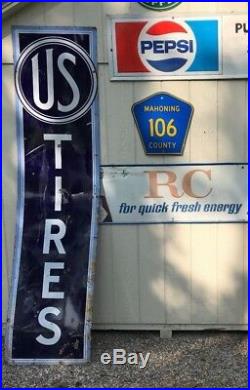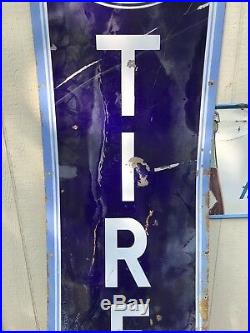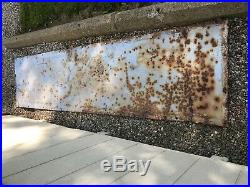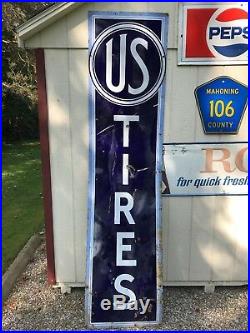VERY RARE VINTAGE ORIGINAL US TIRES SIGN porcelain U S Tire 24 by 96 1920-30s





So here is a VERY RARE VINTAGE ORIGINAL US TIRES SIGN porcelain U S Tire 24 by 96 inch size sign. Sign is in aged used as is condition see pics ding some white spots but overall nice color and shine for age. Sign rarely becomes available for sale. Wiki Loves Monuments: The world’s largest photography competition is now open! Photograph a historic site, learn more about our history, and win prizes. United States Rubber Company. From Wikipedia, the free encyclopedia. The Uniroyal Giant Tire. In Allen Park, Michigan. And other synthetic rubber. Related products, as well as variety of items for military use, such as ammunition. And operations and maintenance. Activities (O&MA) at the government-owned contractor-operated facilities. It was founded in Naugatuck, Connecticut. It was one of the original 12 stocks in the Dow Jones Industrial Average. And became Uniroyal, Inc. As part of creating a unified brand for its products and subsidiaries in 1961. In 1990, Uniroyal was acquired by French. And ceased to exist as a separate business. Today around 1,000 workers in the U. Remain employed by Michelin to make its Uniroyal brand products. Company’s long-lived advertisement slogan was United States Tires are Good Tires. One of Uniroyal’s best known tires is the Tiger Paw introduced in the 1960s and included as original equipment for that decade’s muscle cars. Such as the Pontiac GTO. Which itself was promoted as The Tiger during its early years. Today, Uniroyal still uses the Tiger Paw brand name in its tire line. Goodyear Metallic Rubber Shoe Company & Downtown Naugatuck c. By 1892, there were many rubber manufacturing companies in Naugatuck, Connecticut. As well as elsewhere in Connecticut. Nine companies consolidated their operations in Naugatuck to become the United States Rubber Company. It should be noted that one of the nine, Goodyear’s India Rubber Glove Mfg. Named Litchfield Rubber Co. Until 1847 which manufactured rubber gloves for telegraph linemen was the only company in which Charles Goodyear. Inventor of the rubber vulcanization process, is known to have owned stock. From 1892 to 1913, the rubber footwear divisions of U. Rubber manufactured their products under 30 different brand names, including the Wales-Goodyear Shoe Co. The company consolidated these footwear brands under one name, Keds. In 1916, and were mass-marketed as the first flexible rubber-sole with canvas-top sneakers. 1922 US Tire newspaper ad. On May 26, 1896, Charles Dow. Created the Dow Industrial average of twelve industrial manufacturing stocks, which included among them U. When the average expanded to a list of 20 stocks in 1916, U. Rubber remained, however the listing expanded to 30 stocks in 1928 and U. Rubber Headquarters constructed at 1790 Broadway. In an effort to increase its share of the automobile tire market in 1931, U. Rubber Company bought a substantial portion of the Gillette Safety Tire Company. The company was founded in 1916 by Raymond B. Gillette and its primary manufacturing plant was located in Eau Claire, Wisconsin. The Gillette plant held large contracts with the General Motors. Corporation and with the addition of U. Rubber products, became one of the world’s largest suppliers of original equipment tires. Rubber produced tires under the Gillete, Ward, Atlas, U. During World War II. Rubber factories were devoted to production of war goods, and produced military truck and airplane tires, as well as the canvas-top, rubber-soled Jungle boot. For soldiers and marines serving in tropical and jungle environments. Rubber ranked 37th among United States corporations in the value of wartime production contracts. In 1942, the United States government restricted the sale of scarce rubber products for civilian use and production at the plant dwindled. By December 31, 1943, the need for tires outweighed the need for ammunition. 1 million, and converted it back to synthetic rubber tire production. The company began an expansion and modernization program at the plant that lasted through 1951. When it ended, the Eau Claire plant was the fifth largest tire facility in the United States. The company again expanded the plant in 1965 to produce tires for construction machinery, and for many years it was the largest private employer in Eau Claire and the second largest in neighboring Chippewa Falls. Before it was closed in 1991. In late 1943, U. Louis Marick developed a propeller de-icing system in which a rubber boot was fitted onto the leading edge of a propeller. The boot contained wires that conducted electricity to heat the edge and break-up ice. In 1958, Uniroyal entered into a partnership with the Englebert. Tire company of Liège. Which became known as Uniroyal Englebert Deutschland AG. In 1963, the name was shortened to Uniroyal-Englebert, and in 1967 it became Uniroyal along with all company divisions. Continental continues to market tires under the Uniroyal brand outside NAFTA. Uniroyal plant in Saint-Jérôme, Quebec. Uniroyal operations in Canada were carried out under the name Dominion Rubber Company for a number of decades. Dominion started operations as Brown, Hibbard and Bourne, established in 1854. In 1866, the company registered as the Canadian Rubber Company of Montreal Limited and became prosperous manufacturing waterproof cloth, rubber footwear and machinery belts. It began to produce auto tires in 1906 in its Montreal factory and through a series of mergers with other companies in Ontario and Quebec became the Canadian Consolidated Rubber Company Limited. After another series of mergers, the company became the Dominion Rubber Company Limited in 1926. It produced footwear under a variety of brand names, coated upholstery fabrics, mechanical parts, industrial chemicals and vehicle tires. In 1966, after four decades as Dominion, the company was renamed Uniroyal Ltd. The Saint-Jérôme facility during demolition in 1994. In 1939, Mark Lodge and Harold Hill established S. In Edwardstown, South Australia. The company grew until 1963 when U. The subsidiary which operated Australian plants under the name Uniroyal Tyre Company became Bridgestone Australia Ltd. On 20 March 2007 stockholders of Bridgestone Australia Ltd. Voted to make the company a wholly owned subsidiary of Bridgestone. A joint venture, Isochem, Inc. Was established in June, 1965 together with Martin Marietta Corporation. And chaired by the Martin’s vice president Malcolm A. To operate Hanford nuclear site. Under the auspices of AEC. Uniroyal Mexican Truck Tire. In 1961, the company became Uniroyal, Inc. The Uniroyal name was applied to all its operating components and products by 1967, creating a unified brand. As Uniroyal, the company became defendant in a landmark gender discrimination case, Chrapliwy v. Under Title VII of the Civil Rights Act of 1964. The case continued for several years until the United States Court of Appeals for the Seventh Circuit. Issued a ruling in 1982. In 1985, Uniroyal was taken private by its management and the New York investment firm of Clayton & Dubilier. To prevent a hostile takeover by financier Carl C. At the time, Uniroyal was the fifth-largest tire company in the country. The remaining tire operation was merged with that of B. Listed tire and rubber fabricator that made high-performance replacement tires. The joint venture partnership became the Uniroyal Goodrich Tire Company and B. Goodrich Company held a 50% stake in the new tire company. The new Uniroyal Goodrich Tire Company established its headquarters at the former B. Goodrich corporate headquarters, within its 27-building downtown complex in Akron, Ohio. Which contained Goodrich’s original factory. In the fall of 1987, the B. Goodrich Company closed several manufacturing operations at the site, and most of the complex remained vacant until February 1988, when B. Goodrich announced plans to sell the vacant portions of the complex to the Covington Capital Corporation, a New York developer. However, the merger soon proved to be difficult. In June 1988, B. At the same time, B. The Uniroyal Goodrich Tire Company offered the debt securities in two parts through underwriters. Led by Drexel Burnham Lambert. Also in 1988, Michelin Group, a subsidiary of the French tire company Michelin. Proposed to acquire the Uniroyal Goodrich Tire Company, and began acquiring a stake. With the sale, B. Goodrich then exited the tire business and became the Goodrich Corporation to focus on building its chemicals and aerospace businesses through reinvestment and acquisitions. Michelin Group continued to operate the Uniroyal Goodrich Tire Company as its tire manufacturing unit in the United States and Canada. In January 1991, Michelin Group closed the historic Eau Claire, Wisconsin, plant, eliminating 1,350 positions. Later in 1991 it closed the tire-cord manufacturing plant in Lindsay, Ontario. With 74 workers on August 30, 1991, due to high cost and two tire factories with 1,000 jobs in Kitchener, Ontario. The animated Uniroyal tiger had been a television advertising icon for the company through the 1970s. The new commercial appeared on ESPN and CNN sports-related programming, and also was run by Uniroyal dealers in local markets. By 1993, Michelin North America employed 28,000 people at 18 plants, in South Carolina, Alabama, Oklahoma, Indiana, Nova Scotia and Ontario. In mid-1993, Michelin North America cut 2,500 of those jobs, which represented about 9% of its work force in the United States and Canada, because of softening demand for tires. As of 2010, the Uniroyal Goodrich Tire unit continued to operate with about 1,000 workers at its tire plant in Woodburn, Indiana. And another plant in Tuscaloosa, Alabama. Citing overcapacity in the North American tire market, the. The item “VERY RARE VINTAGE ORIGINAL US TIRES SIGN porcelain U S Tire 24 by 96 1920-30s” is in sale since Saturday, March 30, 2019. This item is in the category “Collectibles\Advertising\Tires\Other Tire Advertisements”. The seller is “erp7777″ and is located in Elma, New York. This item can’t be shipped, the buyer must pick up the item.
- Type of Advertising: Sign
- Brand: US TIRES
- Original/Reproduction: Original
- Country/Region of Manufacture: United States
- Date of Creation: 1920-30s

Recent Posts
- Vintage BF Goodrich tire display sign
- 20 Perfect Classic Cars Under 15 000 Available On Craigslist Marketplace Big Sale
- RARE Vintage MOHAWK TIRES Metal Advertising RECAPPING MOLD TIME SIGN #2
- Vintage Firestone Tire Insert Store Display Sign Smooth Dangerous Tires
- Vintage LEE Tire Heavy Metal Sign Painted Original Advertising service gas oil
Archives
- November 2024
- October 2024
- September 2024
- August 2024
- July 2024
- June 2024
- May 2024
- April 2024
- March 2024
- February 2024
- January 2024
- December 2023
- November 2023
- October 2023
- September 2023
- August 2023
- July 2023
- June 2023
- May 2023
- April 2023
- March 2023
- February 2023
- January 2023
- December 2022
- November 2022
- October 2022
- September 2022
- August 2022
- July 2022
- June 2022
- May 2022
- April 2022
- March 2022
- February 2022
- January 2022
- December 2021
- November 2021
- October 2021
- September 2021
- August 2021
- July 2021
- June 2021
- May 2021
- April 2021
- March 2021
- February 2021
- January 2021
- December 2020
- November 2020
- October 2020
- September 2020
- August 2020
- July 2020
- June 2020
- May 2020
- April 2020
- March 2020
- February 2020
- January 2020
- December 2019
- November 2019
- October 2019
- September 2019
- August 2019
- July 2019
- June 2019
- May 2019
- April 2019
- March 2019
- February 2019
- January 2019
- December 2018
- November 2018
- October 2018
- September 2018
- August 2018
- July 2018
- June 2018
- May 2018
- April 2018
- March 2018
- February 2018
- January 2018
- December 2017
- November 2017
- October 2017
- September 2017
- August 2017
- July 2017
- June 2017
- May 2017
Categories
- 18ft
- 18×18
- 1920-30s
- 1920s
- 1930's
- 1940s
- 1950's
- 1960-1980
- 1960-s
- 1960s
- 1970s
- 1990s
- 2-vintage
- 20x5new
- 25×18
- 2×17
- 32×25
- 36×21
- 50's
- 6''vintage
- 8''vintage
- abandoned
- advertising
- airbag
- almost
- always
- amazing
- american
- animated
- another
- antibiotics
- antique
- antiques
- antiquevintage
- apple
- approx
- armstrong
- arthur
- astrostar
- atlas
- attending
- auction
- austin
- authentic
- automotive
- avoid
- avon
- balance
- bandag
- basic
- batteries
- beautiful
- been
- beginners
- belgium
- best
- bibendummichelin
- bicycle
- bikes
- bill
- blue
- boot
- bottle
- bought
- brand
- bridgestone
- bruno
- brunswick
- build
- building
- burning
- buying
- california
- call
- camel
- cassettes
- cave
- celebrity
- chance
- change
- changing
- charge
- charlie
- chase
- check
- chembond
- chevrolet
- chevy
- chryco
- chumlee
- classic
- classical
- clean
- cleaning
- close
- co-op
- coats
- coca
- coin
- collectible
- collecting
- collection
- collectors
- color
- colored
- commercial
- complete
- completely
- confrontation
- confusing
- continental
- cool
- cooper
- cordless
- cracked
- cracking
- crated
- crazy
- create
- creatures
- creep
- customer
- cyclists
- danger
- dangerous
- dared
- dayton
- deals
- debunking
- delta
- deserted
- determine
- develop
- diagnose
- diagnosing
- digging
- diresta
- discount
- display
- dodge
- dogo
- dollar
- door
- double
- dream
- drew
- dunlop
- durango
- early
- earth
- easy
- ebay
- epic
- excellent
- explaining
- exploring
- extremely
- fake
- family
- farmhouse
- fascinating
- fastest
- favorite
- federal
- feels
- figure
- find
- finding
- finds
- firestone
- first
- fisk
- fisogni
- flange
- flanged
- flash
- flat
- fontana
- foot
- ford
- found
- frauds
- free
- friday
- funny
- garage
- gasoline
- general
- generate
- genius
- genuine
- getting
- giant
- gillette
- glendale
- glenn
- going
- good
- goodrich
- goodyear
- grandfather
- grid
- guaranteed
- gulf
- gutta
- hand
- handyman
- hanging
- happens
- happy
- harley-davidson
- haven
- hazards
- heavy
- hercules
- hide
- hood
- horizontal
- huge
- hughie
- idaho
- identify
- inch
- incredibly
- independence
- india
- industrial
- inkscape
- inland
- insane
- install
- iowa
- jack
- jackie
- japanese
- jason
- jeep
- jimmy
- jittering
- john
- juice
- karma
- kelly
- kendrick
- kent
- know
- kokomo
- kraft
- kumho
- laramie
- large
- large-vintage
- laugh
- laura
- leather
- life
- light
- lighted
- limited
- live
- lots
- loud
- lqqk
- lucas
- made
- magician
- major
- make
- making
- mandela
- mansfield
- mantiques
- maracas
- marathon
- marquee
- massive
- maxx
- mccreary
- meaning
- measure
- meet
- melbourne
- michelin
- mobile
- mods
- mohawk
- mohwak
- moments
- monkey
- monroe
- most
- motorbike
- motorcycle
- motors
- mount
- moura
- much
- must
- nascar
- national
- neighbors
- neon
- never
- nice
- night
- nitrous
- ntique
- oakland
- oblong
- odell
- olveston
- onthehunt
- orig
- original
- overland
- ozzy
- pair
- parking
- part
- patched
- pate
- patented
- pawn
- pennsylvania
- people
- perfect
- permanent
- pharis
- phillips
- photos
- picked
- picking
- pickup
- pioneer
- pirelli
- plug
- pontiac
- poor
- porcelain
- prevent
- proper
- pulling
- quickly
- radioactive
- random
- rare
- read
- real
- really
- recap
- recapping
- recommend
- record
- recycle
- recycling
- reduced
- remington
- remove
- repair
- replace
- replacing
- reproduction
- resellling
- reset
- restoring
- retreading
- revival
- richmond
- road
- robert
- rotted
- rough
- royal
- rubbers
- runflat
- safemark
- savage
- saving
- scale
- scammed
- scarce
- school
- schwinn
- searching
- second
- sections
- seiberling
- separated
- seriously
- shakedown
- shell
- shocked
- shocking
- shoe
- shop
- shopping
- should
- shred
- sign
- signal
- signs
- simple
- sinclair
- smith
- smoken
- smokey
- some
- someone
- somewhere
- soon
- sooo
- southern
- span
- split
- sports
- spot
- spring
- starley
- station
- steves
- stick
- stomil
- study
- stuff
- stunt
- style
- sumitomo
- sunoco
- super
- sure
- sustainable
- symptoms
- tahoe
- taio
- take
- takes
- tamiya
- tech
- telechron
- tell
- telltale
- tere
- texaco
- things
- thrift
- thrifting
- time
- tinker
- tips
- tire
- tires
- tirestarz
- town
- toyo
- toyota
- trail
- trailer
- training
- transit
- trashing
- treasure
- trick
- trio
- troubleshooting
- turbo
- turtle
- tyre
- tyres
- tyrese
- ultra
- Uncategorized
- uncovering
- union
- unique
- united
- used
- using
- vance
- veerana
- very
- vibration
- vintag
- vintage
- vintage''firestone
- vintage''firetone
- vintage''good-year
- vintage'india
- vintage'ralson'
- vintage-original
- vintage17-34x
- vintage1962
- vintageatlas
- vintageearly
- vintagegulf
- visit
- visiting
- vitreous
- vlog
- vntg
- wagner
- wall
- wards
- warning
- warnings
- watch
- were
- western
- westlake
- wheel
- wheels
- where
- whiskey
- white
- whitewall
- wholesale
- wide
- willys
- woman
- wood
- wooden
- workshop
- world
- worlds
- worst
- y5201
- year
- yellow
- yokohama
- zero
- zowhat
